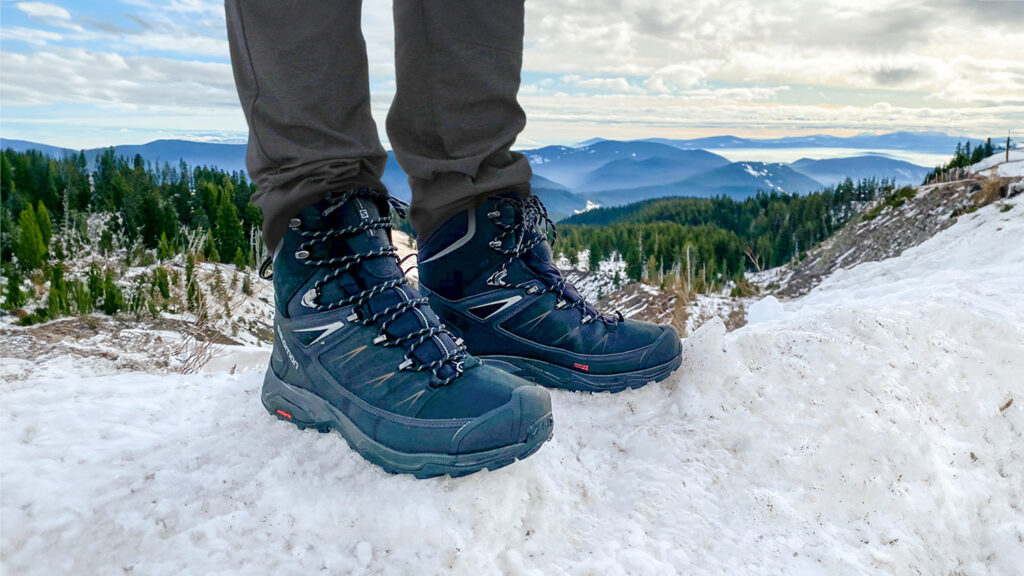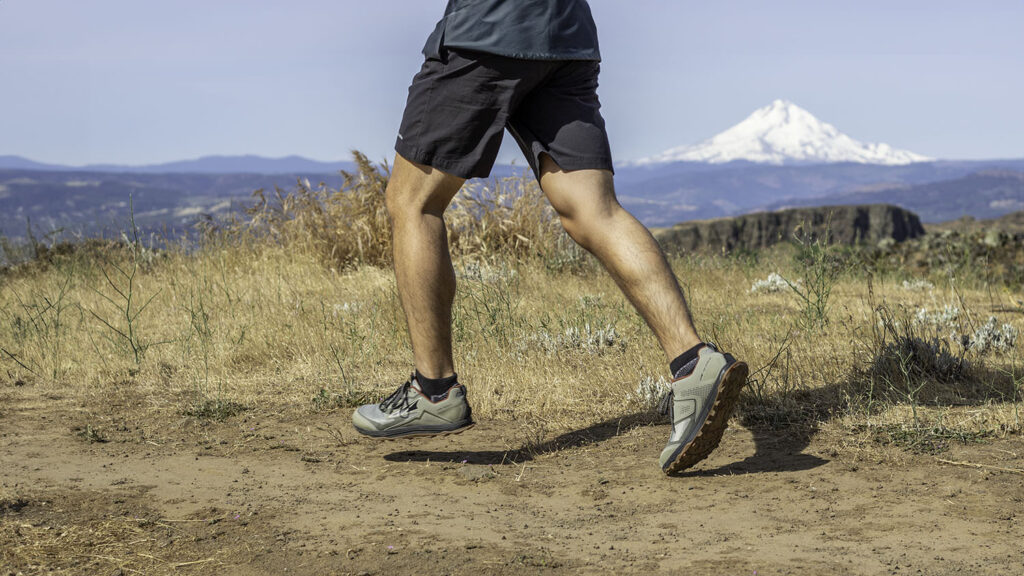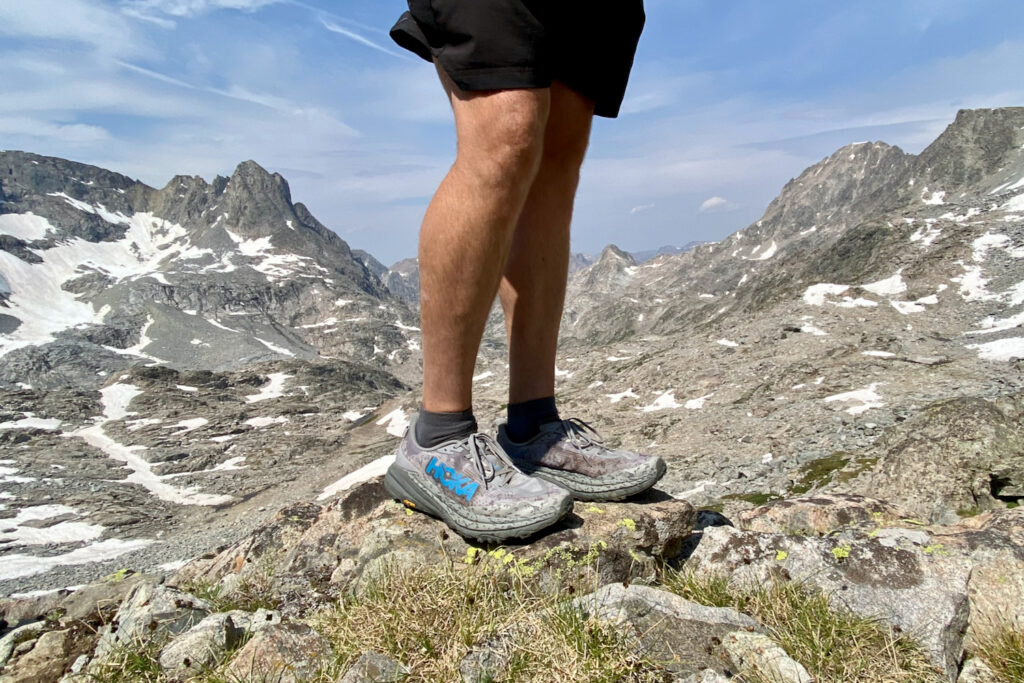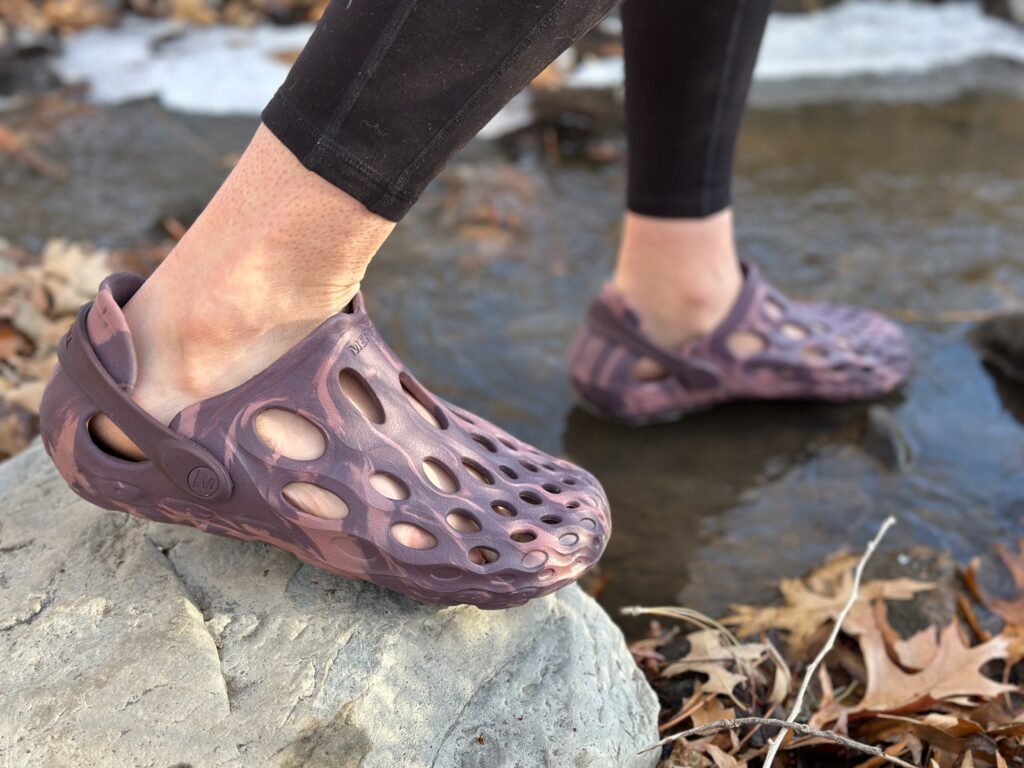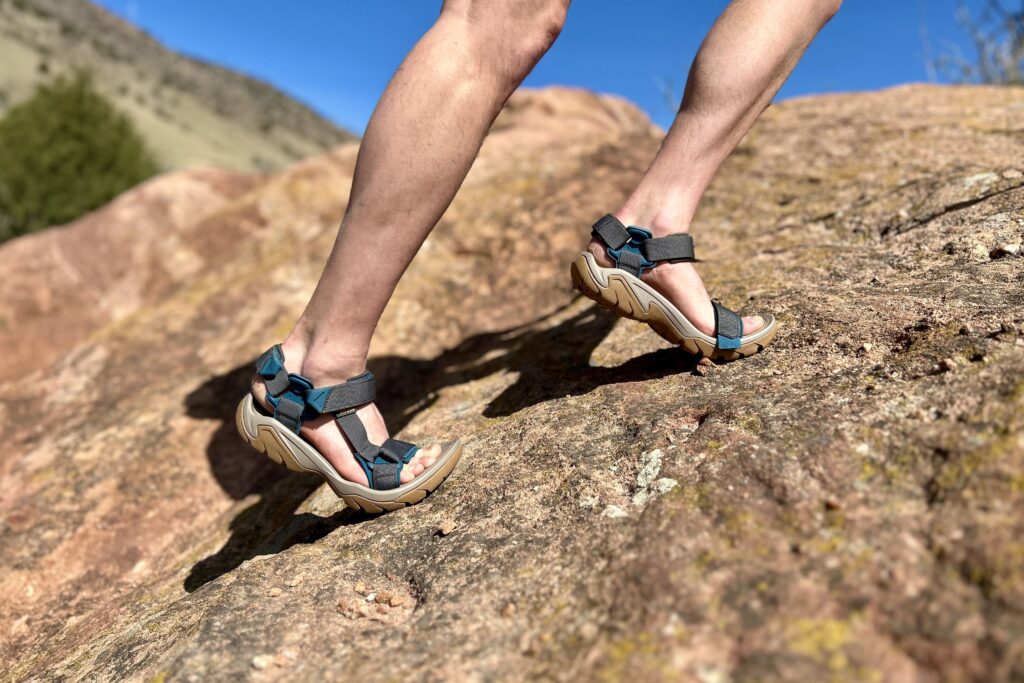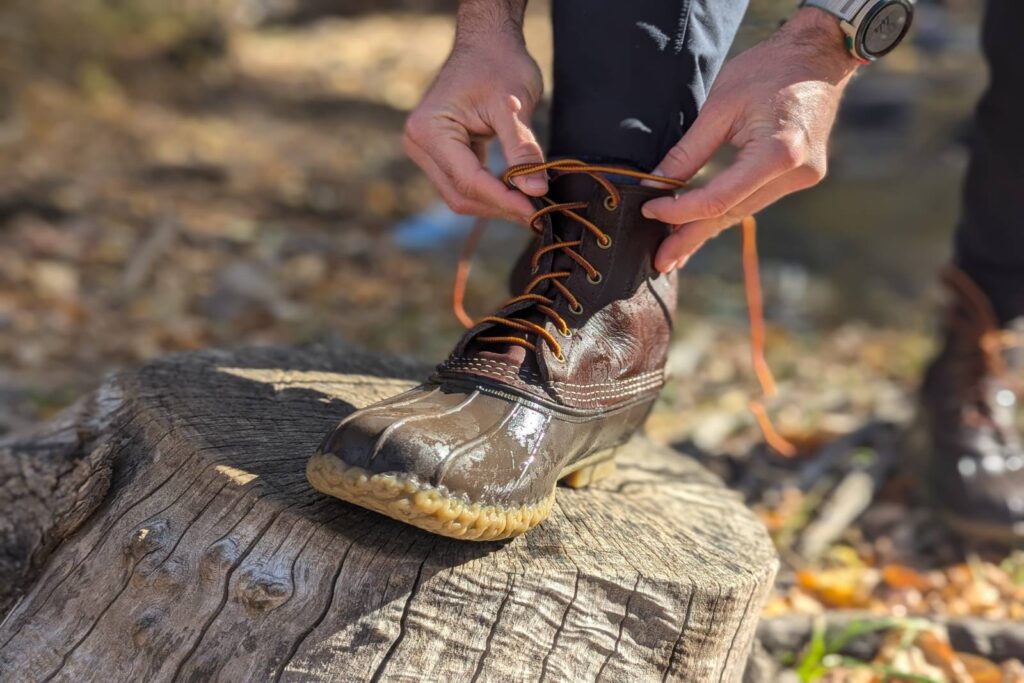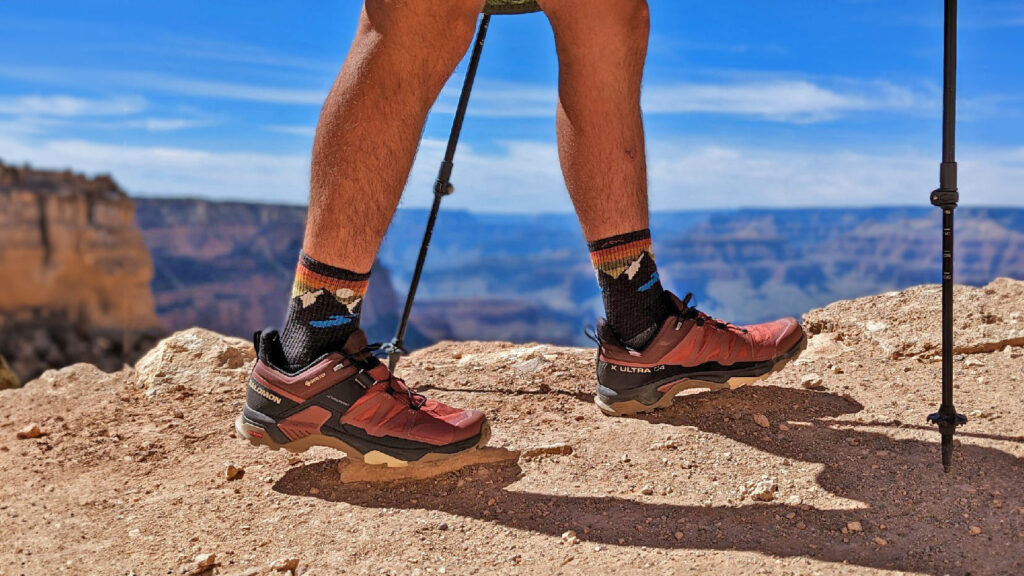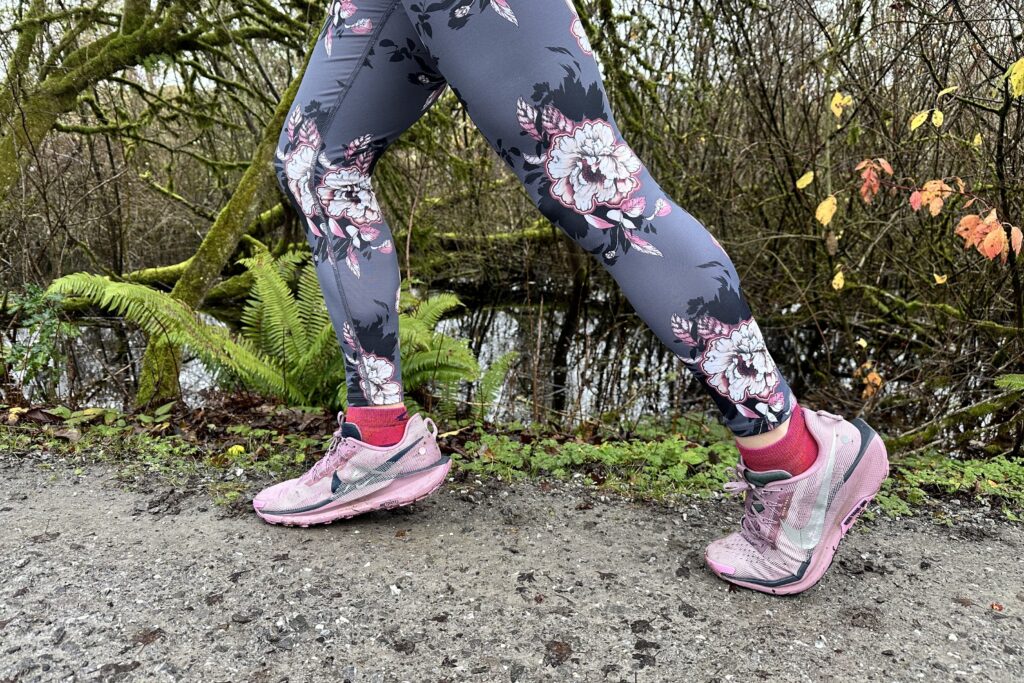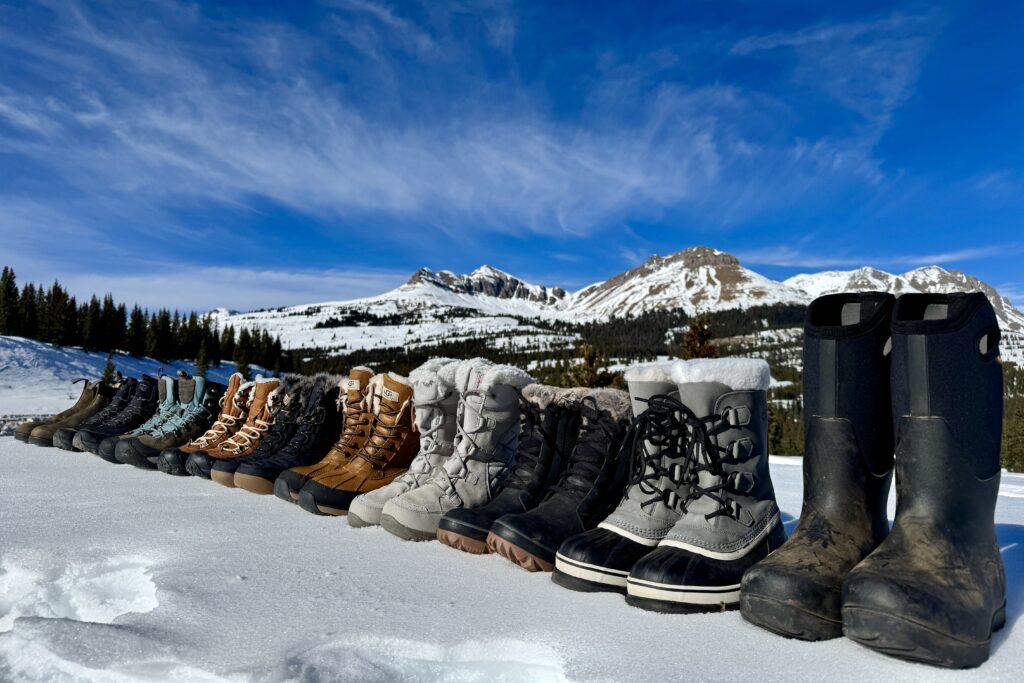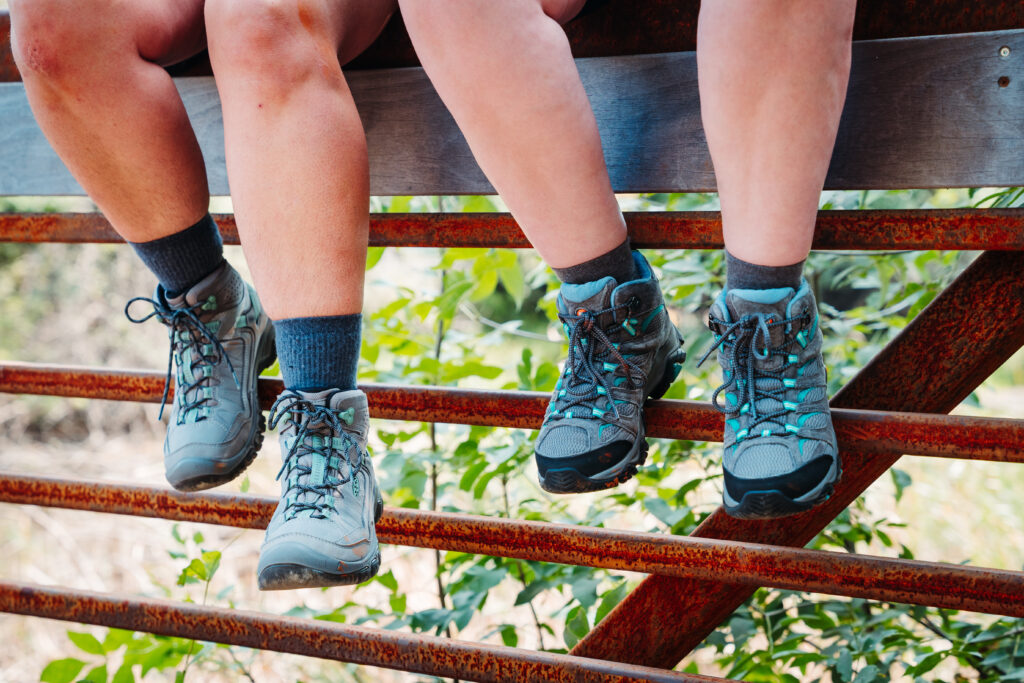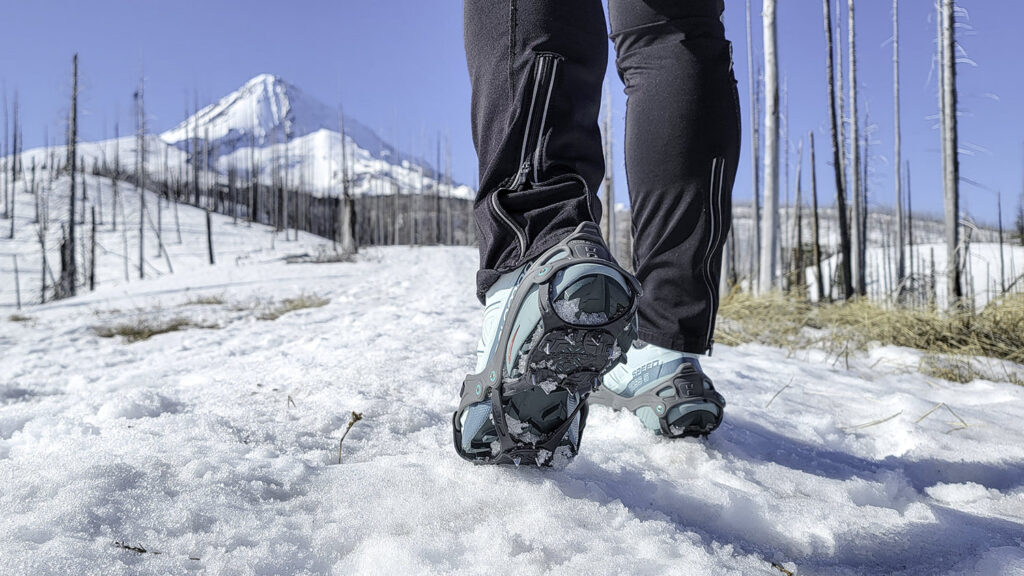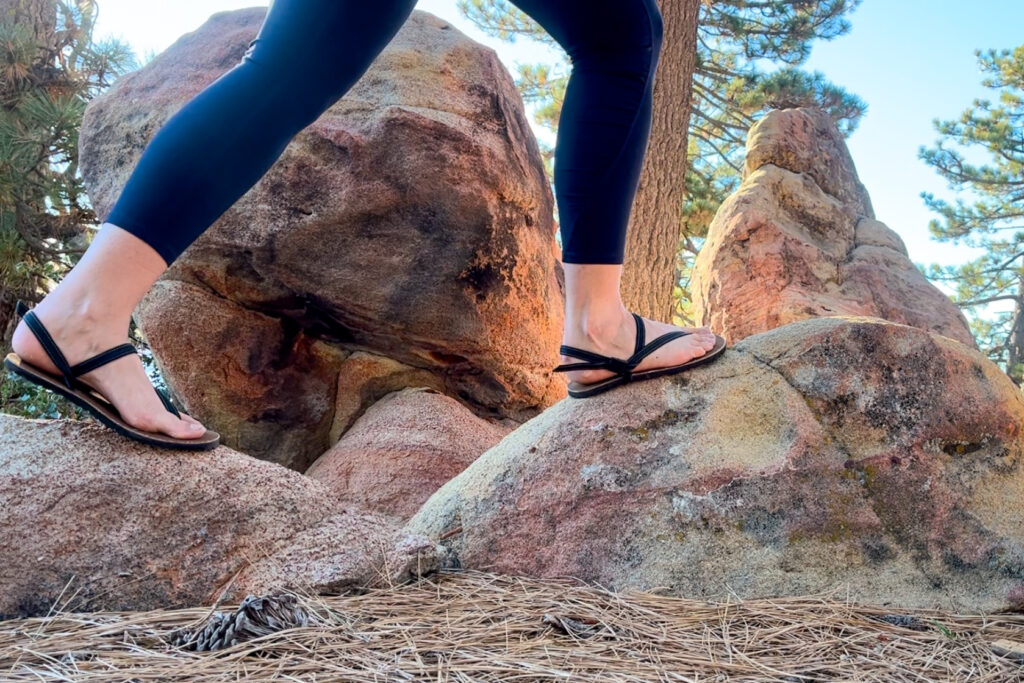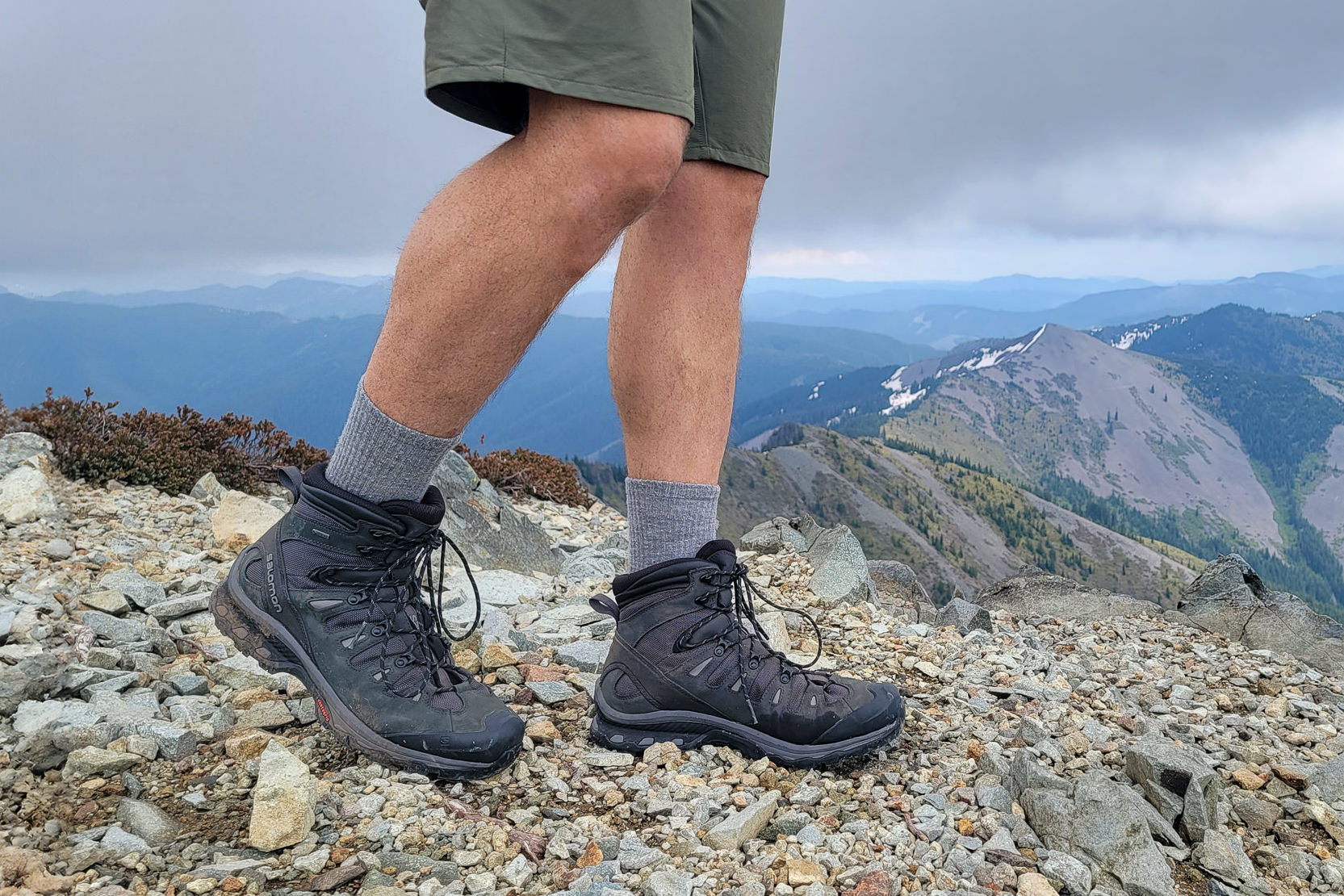
It’s important to treat your feet right on the trail. But when you’re looking for a new pair of hiking boots, you’ll quickly find there’s a lot to consider – like ankle support, comfort, weight, durability, traction, and weather resistance.
Our team of footwear experts has tested these features on dozens of boots from brands like Salomon, Merrell, La Sportiva, LOWA, KEEN, and more. It’s our mission to help you find the perfect pair to keep your feet happy and protected on the trail.
And for more info, check out some of our other popular gear guides:
Quick Picks for Men’s Hiking Boots
Check out this quick list of our favorites if you’re in a hurry, or continue scrolling to see our full list with in-depth reviews.
Best Hiking Boots Overall: Salomon X Ultra 5 GTX ($185)
Best Hiking Boots for Support, Durability & Comfort: LOWA Renegade EVO GTX ($280)
Best Cold-Weather Boots: adidas Terrex Skychaser AX5 Mid GORE-TEX CLIMAWARM+ ($160)
Best Balance of Weight, Durability & Support: Salomon Quest 4 GTX ($230)
Best Synthetic Hiking Boots: Oboz Katabatic LT Mid GTX ($190)
Best Synthetic Hiking Boots: La Sportiva Ultra Raptor II ($220)
Best Budget Hiking Boots: Merrell Moab 3 WP ($170)
Best Wide-Fit Hiking Boots: KEEN Targhee IV WP ($180)
Versatile & Lightweight Hiking Boots: HOKA Anacapa 2 Mid GTX ($195)
Best Zero-Drop Hiking Boots: Vivobarefoot Tracker Forest ESC ($260)
Durable & Supportive Leather Hiking Boots: KEEN Hightrail Mid WP ($155)
Budget Hiking Boots for Beginners & Occasional Hikers: Columbia Newton Ridge Plus 2 WP ($100)
What’s new
We’ve updated our picks and rankings for fall, 2025:
- The recently updated Salomon X Ultra 5 GTX takes our top spot for almost every metric, including comfort, durability, and traction.
- The newly released adidas Terrex Skychaser AX5 Mid GORE-TEX CLIMAWARM+ makes a strong debut on our gear guide at #2 as winter hiking boot.
- The Oboz Katabatic LT Mid GTX also joins the party as the best boot for fastpacking.
Men’s Hiking Boots Overall Testing Scores
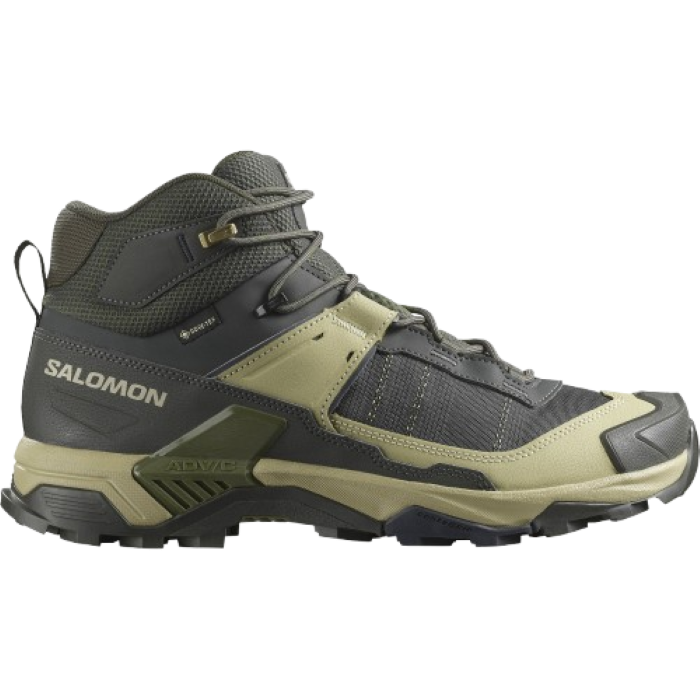
Men’s Salomon X Ultra 5 Mid GTX
Best Hiking Boots Overall
CleverHiker Rating: 4.8/5.0
Price: $185
Weight (Pair): 1 lb. 15 oz.
Upper Material: Poly-coated leather
Sizing: Wide available
Pros
- Minimal break-in
- Excellent traction
- Ultralight
- Stable
- Good for lightweight backpacking
Cons
- Less ankle support than some
- Not as durable
- Flimsy insert
The Salomon X Ultra 5 Mid GORE-Tex Men’s Hiking Boots are a go-to choice for hikers who want the comfort and agility of a trail shoe with added ankle coverage and waterproofing. They’re lightweight, flexible, and feel fast underfoot, perfect for day hikes, fast-packing, or weekend trips.
We found them to be especially comfortable for hikers with average to low-volume feet. Although, the toe box and forefoot run narrow. Salomon does offer a wide version, but sizing still runs a little small overall. The soft synthetic upper flexes naturally, and there’s plenty of cushioning in the ankle and tongue. A short break-in period helped them mold to our feet quickly, but they were still plenty comfortable right out of the box.
Traction was one of the standout features in testing. These boots gripped well on wet granite, dusty singletrack, and muddy trails. The GORE-TEX membrane also held up through slushy snow and shallow creek crossings, keeping our feet dry and warm. However, breathability was limited, and the boots ran hot during sunny fall hikes.
These aren’t ideal for hikers who haul heavy loads or those who need extra structure for off-trail travel. The support is moderate at best, and the flexible build can feel a little loose on steep sidehills with a full pack. Long-term durability is solid for a synthetic boot, but you do give up some toughness to achieve this low weight. Overall, we like them best for when you want to cover ground without lugging around a heavy boot.
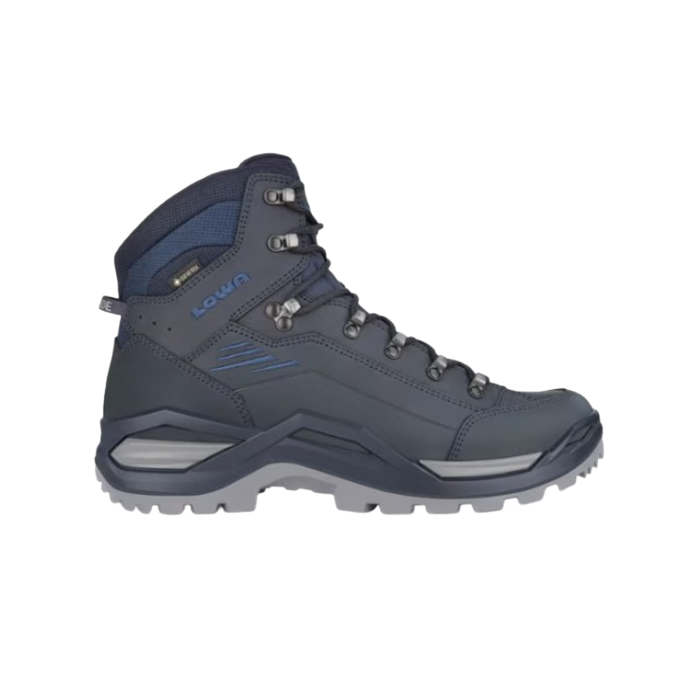
Men’s Lowa Renegade EVO GTX
Best Hiking Boots for Support, Durability & Comfort
CleverHiker Rating: 4.7/5.0
Price: $280
Weight (Pair): 2 lb. 10 oz.
Upper Material: Nubuck leather
Sizing: Wide & narrow available
Pros
- Comfortable
- Durable
- Outstanding traction
- Stable
- Good lacing system
- Excellent ankle support
Cons
- Expensive
- Medium break-in period
- Traction can collect debris
- Run hot above 75°F
The Lowa Renegade EVO GTX is a classic leather hiking boot that offers stellar durability, outstanding foot protection, and excellent traction. If your hikes flip-flop between established, well-packed trails and challenging off-trail adventures, the Renegade is the boot you’ve been looking for.
These boots offer a thick but flexible sole with a robust lug pattern that lends outstanding stability to get where you’re going without foot fatigue. Plus, the Renegade’s sleek profile, metal grommets, and variety of earth-tone colorways make for a stylish boot. Whether you’re walking the dog through the neighborhood in freezing winter temperatures or hiking in spring rain, the Gore-Tex liner and Nubuck Leather upper create a waterproof boot that extends well over the ankle with an angled collar.
There’s a lot to like about the Renegades, but be ready to shell out for them. They are one of the most expensive boots on this list. That said, you’ll be hard-pressed to find a more durable pair almost anywhere – these boots are built to last. That means you won’t have to replace your footwear as often as synthetic or lesser-made boots.
This model is also in the bottom half of the pack for weight, making it heavier than previous iterations. Despite their average weight, the Renegades are comfortable and easy to love. Unlike many hiking boots in this price range, the Renegades almost entirely avoid the pitfalls of traditional leather hiking boots of being stiff, cumbersome, and heavy. Even though they have a medium break-in period, once they’ve softened, they could easily become your all-time favorite boots.
When it comes to unparalleled ankle support and best-in-class stability, the Lowa Renegades outperform the competition. Thanks to a super-structured upper and outsole, the Renegades are built for hikers who are ready for off-trail adventures in a durable, stable, comfortable package.
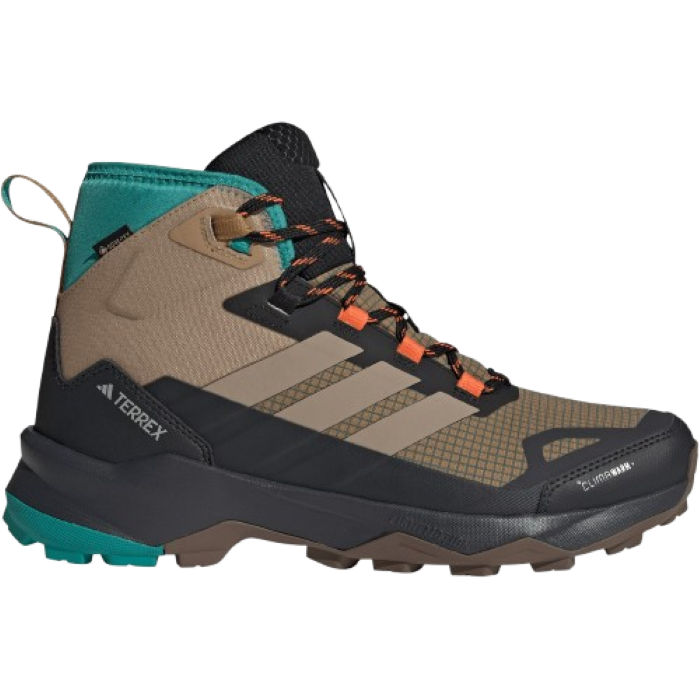
Men’s adidas Terrex Skychaser AX5 Mid GORE-TEX CLIMAWARM+
Best Cold-Weather Boot
CleverHiker Rating: 4.7/5.0
Price: $160
Weight (Pair): 2 lb. 1.4 oz.
Upper Material: Ripstop with overlays
Sizing: regular
Pros
- Lightweight
- Comfortable
- Solid waterproofing
- Insulated for cold weather
Cons
- Runs small
- Long break-in period for a synthetic boot
The adidas Terrex Skychaser AX5 Mid GORE-TEX CLIMAWARM+ is a new option for hikers looking for a winter-ready boot that doesn’t feel bulky or overbuilt. Designed for cold, wet conditions, it combines insulation, waterproof protection, and a supportive build in a package that still feels agile underfoot. It’s not your average lightweight hiking boot; it’s warmer, stiffer, and protective, making it a great choice for easy winter adventures.
Where the Skychaser differs from most boots on our gear guide is in cold-weather performance. The CLIMAWARM+ insulation kept our feet warm during snowy hikes and frosty mornings, and the GORE-TEX membrane did its job to seal out moisture. The mid-height cuff and stiff upper add structure and moderate ankle support, especially on off-camber or technical trails. These insulated boots obviously run hot, so you wouldn’t want to wear them for summer hikes or warmer shoulder season conditions.
The biggest drawback is the fit. These boots run small and are not offered in wide sizes, which will be a dealbreaker for some. They also take longer than average to break in for a synthetic boot, but the comfort improves noticeably over time.
Ultimately, the Skychaser is a great fit for fast-moving hikers tackling cold, wet trails who want more protection than a typical three-season hiker.
More: Adidas Terrex Skychaser AX5 Mid GORE-Tex Review
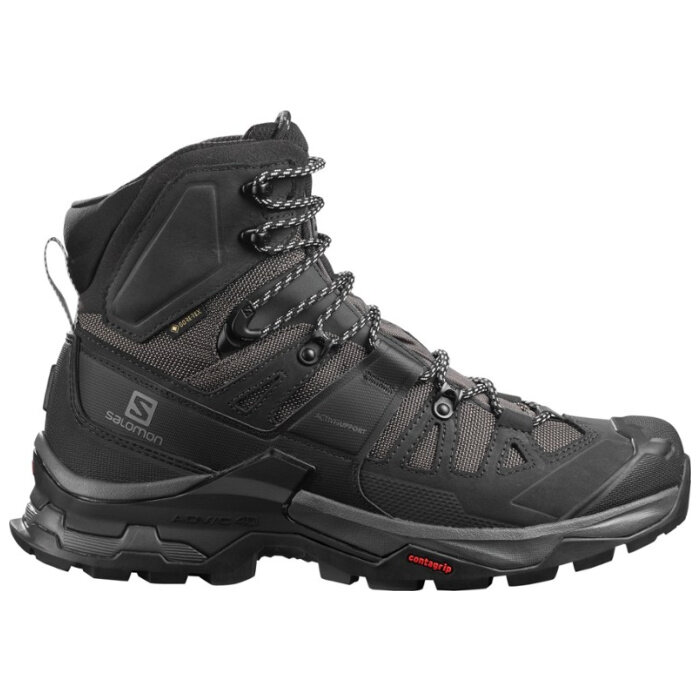
Men’s Salomon Quest 4 GTX
Best Balance of Weight, Durability & Support
CleverHiker Rating: 4.6/5.0
Price: $230
Weight (Pair): 2 lb. 14 oz.
Upper Material: Leather/mesh
Sizing: Regular width
Pros
- Excellent ankle support
- Stable
- Durable
- Protective toe cap
- Great traction
- Supportive soles
- Good for backpacking with a heavier load
Cons
- Heavier than some
- Medium break-in period
- Stiff soles
- Top lace eyelets can dig into foot
- Lacing system is a bit tedious
The Salomon Quest 4 GTX offers seriously burly ankle support, which translates to unrivaled stability on almost any terrain. A mix of leather and mesh textiles combined with a GORE-TEX liner will keep your feet reliably dry through water crossings and well-protected on rocky trails. The Quest 4’s aggressive lug design offers great traction, and the boots are ergonomic and comfortable out of the box. The CleverHiker team really likes these boots, and they’ve ranked highly on our list for years.
However, the Quest 4 GTX is also one of the heaviest boots we tested. If you carry 40 or more pounds in your backpack, they may be the perfect fit for you. Despite the weight penalty, these boots feel considerably more agile and lightweight than boots in a similar weight category.
The Quests are spendy, but for us, they’re worth the price tag. These are super comfortable, supportive, and easy-to-love hiking boots that will help you crush hundreds of miles of trail, from high desert to above treeline.
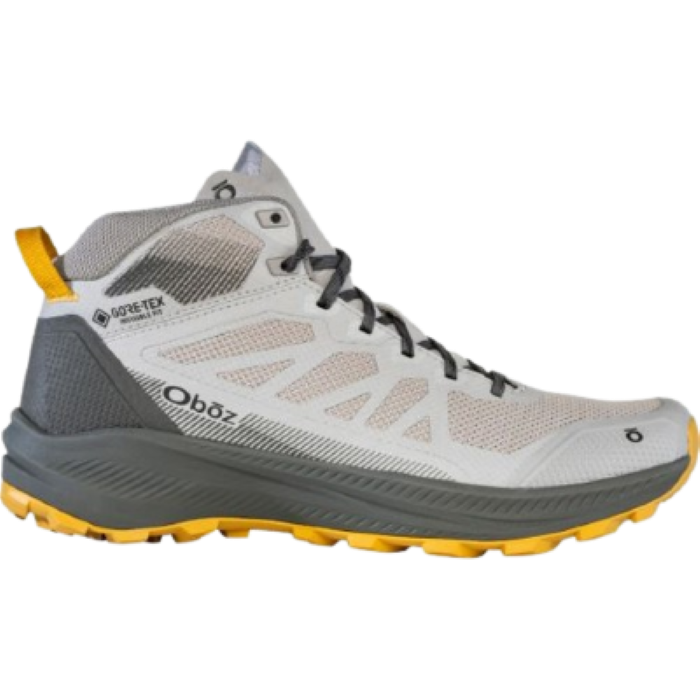
Men’s Oboz Katabatic LT Mid GTX
Best Boot for Fastpacking
CleverHiker Rating: 4.6/5.0
Price: $190
Weight (Pair): 1 lb. 9.6 oz.
Upper Material: Recycled polyester
Sizing: Wide available
Pros
- Comfortable
- Breathable waterproofing
- Stable
- Excellent traction
- Lightweight
Cons
- Durability
- Not the best for scrambling
- Expensive
The Oboz Katabatic LT Mid GTX is one of the best lightweight, mid-height hiking boots we’ve tested. It’s ideal for fast-moving hikers who still want solid support, solid waterproofing, and a nimble feel on the trail. With a flexible synthetic build and minimal break-in required, it delivers the lightweight feel fast packers crave – with just enough structure to make it more capable than a typical trail shoe.
What impressed us most during testing was how well the Katabatic balanced comfort and capability. It’s lightweight but still provides enough structure to handle moderate loads. The addition of wide sizing was a much-needed improvement over past versions, and the GORE-TEX membrane kept our feet dry through steady rain, snowmelt, and shallow stream crossings in Colorado’s Front Range. Underfoot, the Katabatic feels light, springy, and responsive, making long days on the trail feel easier and more efficient.
That said, this boot isn’t built for everything. It doesn’t have the stiffness or protection needed for technical alpine scrambles or extended, heavy-load hikes. And while the lightweight synthetic materials are well-constructed, they’re more prone to wear than a boot with leather uppers. For hikers who often venture off-trail or hammer their gear season after season, something like the Lowa Renegade or Salomon Quest 4 GTX may hold up better long-term.
For most 3-season hikers, the Katabatic LT Mid GTX offers an excellent blend of comfort, support, and protection without the weight penalty. It’s breathable, waterproof, stable enough for most terrain, and lightweight for a hiking boot.
More: Oboz Katabatic LT Mid GTX
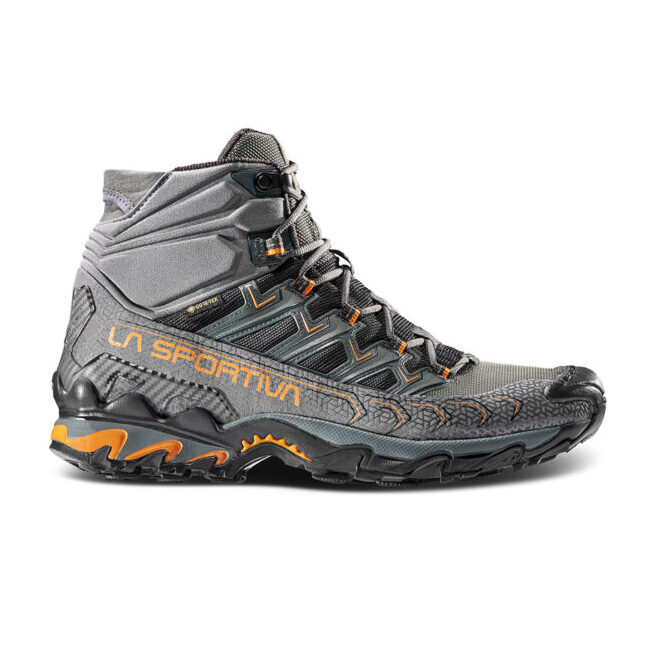
Men’s La Sportiva Ultra Raptor II Mid GTX
Best Synthetic Hiking Boots
CleverHiker Rating: 4.6/5.0
Price: $220
Weight (Pair): 1 lb. 11 oz.
Upper Material: Poly & plastic
Sizing: Wide available
Pros
- Waterproof
- Snug fit
- Flexible, comfortable uppers
- Sticky traction
- Supportive
- Lightweight
- Huge toe guard
Cons
- Less durable than some
- Expensive
- Toe box and fit narrower than average
- Less ankle support than average
- Limited colorways
The La Sportiva Ultra Raptor II Mid GTX feel stable, comfortable, and agile, making them our top recommendation for a fully synthetic boot. At barely over a pound per boot, the Raptor IIs are flexible and light for fast movement like a trail shoe, but offer impressive waterproofing and ankle protection like a much heavier leather boot. The Ultra Raptors have a grippy lug pattern with outstanding traction on everything from wet logs to sandy slopes and offer plenty of support on steep descents.
However, the Raptor IIs, like much of La Sportiva’s footwear, tend to run a bit narrow, so we recommend sizing up if you have wider feet. And, research shows that shoes made with synthetic materials wear out faster than leather or hybrid options. These are sturdy, well-built boots, but they may not last quite as long as the leather options on this list.
If you crave technical precision and great support on rough terrain, or you’re just looking for a lightweight, versatile boot for most hiking conditions, the Raptor II boots are ready for adventure. They offer top-notch grip, great waterproofing, and fast footing whether you’re carrying a heavy backpack on smooth dirt trails or tackling rough and rocky terrain off the beaten path.
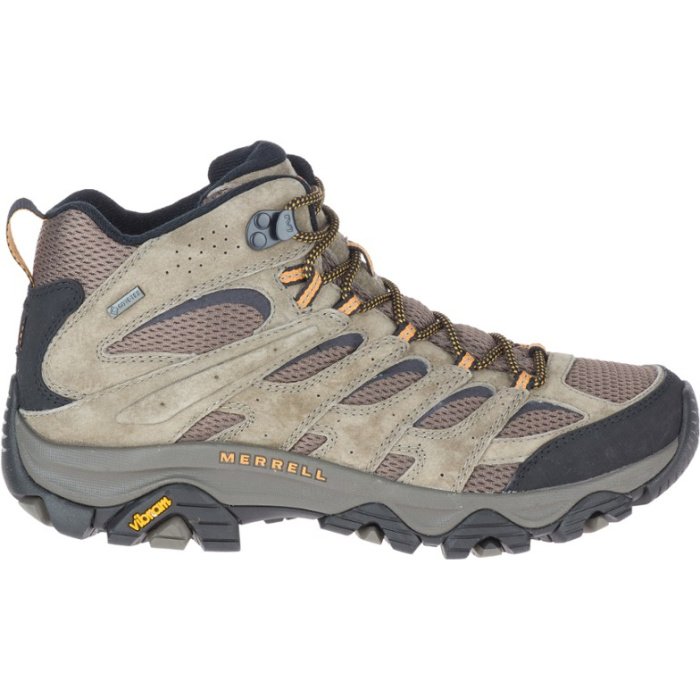
Men’s Merrell Moab 3 WP
Best Budget Hiking Boots
CleverHiker Rating: 4.7/5.0
Price: $170
Weight (Pair): 2 lb. 4 oz.
Upper Material: Leather/mesh
Sizing: Wide available
Pros
- Less expensive
- Comfortable and supportive
- Minimal break-in
- Durable
- Breathable
- Easy to put on / take off
- Reliable traction
Cons
- Bulky
- Thin insole
- Runs wide
- Heavier than some
The Merrell Moab 3 WP offers the best bang for your buck on this list. At only $150, these boots offer great value, which is why the Moabs have been at the top of our Best Hiking Boots lists (Men and Women) for years. The CleverHiker team has taken Moabs on hundreds of adventures to keep our feet dry and comfy – from wet day hikes with kids in the Washington Cascades and New Hampshire’s White Mountains to frigid trails in the Colorado Rockies, and massive mid-February blizzards in the city.
The Moab 3s are trusted, ultra-popular, waterproof hiking boots that hit the sweet spot for weight, durability, and superior comfort. We’ve found the beefy midsole, wide toe box, and long, grippy laces make these boots feel very adjustable and comfy on almost any terrain. The lug pattern is aggressive and knobby, so you’ll feel stable whether you’re on a groomed, flat forest path, climbing a steep trail, or scrambling to a summit.
The Moab 3s are a bit bulky, so a lighter weight option will serve you better for long days (over 15 miles) with a lot of elevation gain. And, the insole is on the thinner side so we’ve found adding aftermarket inserts helps with arch support.
All things considered, Merrell is at the top of its game with these boots. They have good breathability to prevent sweat buildup and offer strong durability – including a reinforced heel and toe cap. When it comes to reliable and high-quality footwear that is affordable and ready for adventure, take a closer look at the Moab 3s.
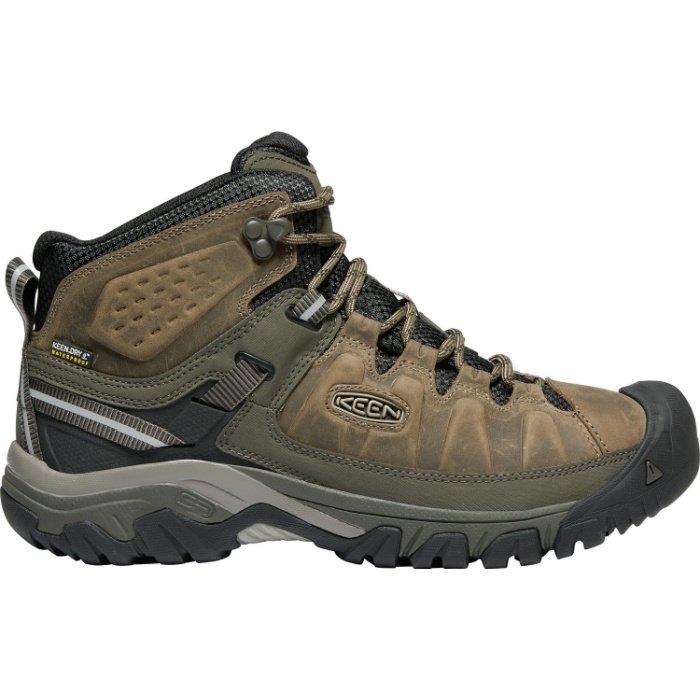
Men’s KEEN Targhee IV WP
Best wide-fit hiking boots
CleverHiker Rating: 4.5/5.0
Price: $180
Weight (Pair): 2 lb. 9 oz.
Upper Material: Nubuck leather
Sizing: Wide available
Pros
- Wide fit
- Comfortable and supportive
- Snug lacing system
- Short break-in time
- Protective toe cap
- Good weather resistance
Cons
- Less ankle support
- Less durable than some
- Traction not as effective on steep inclines / declines
- Average weight
If you’re looking for roomy boots, the KEEN Targhee IV Mid WP is your glass slipper. They offer a ton of room in the toe box so your feet can stretch out, and they come in wide sizes to accommodate an array of foot shapes. Between their comfort, wide fit, and classic profile, these boots are super popular. We liked them so much that the low-cut version of the Targhee IV lands on our guide to the Best Hiking Shoes for Men as well.
The Targhee IV has an unusual, supportive design feature: a nylon strap that wraps from the sides of the boots around the back of the heel, which makes the fit feel snug and locked in, perfect for traversing rocky trails and tackling steep descents. With a flexible leather upper and a slightly more flexible sole than other similar boots on this list, these KEENs are comfy out of the box and have a short break-in period.
The uppers of the Targhee IV are softer than other leather boots on this list, which means they are immediately comfortable, but they’re a bit less protective for your ankles. Also, the grip pattern on the Targhee IV is wide and simple with shallower lugs. The outsole wears out slightly faster than average but this model still offers excellent traction on most surfaces.
They walk a fine line between support and flexibility. When it comes to a wide-fitting, super comfortable, and affordable mid-range hiking boot, the KEEN Targhee IV earns its place.
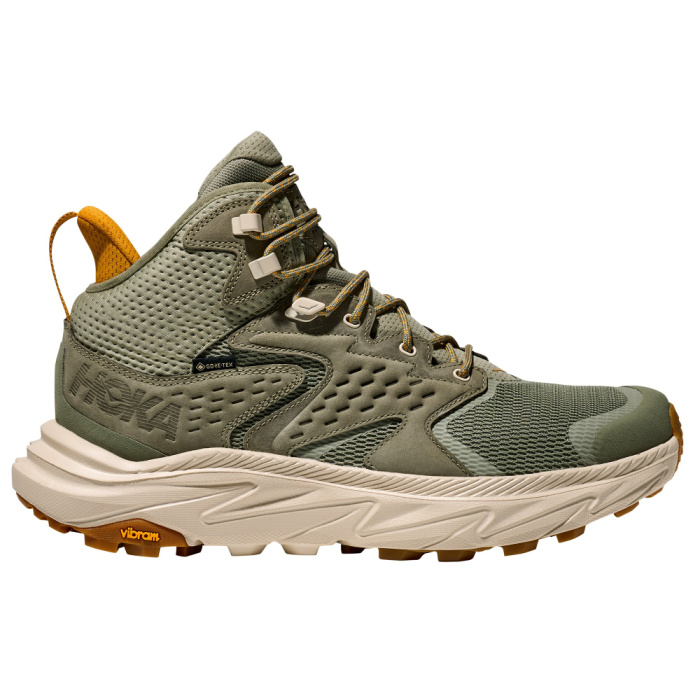
Men’s HOKA Anacapa 2 Mid GTX
Versatile & Lightweight Hiking Boots
CleverHiker Rating: 4.5/5.0
Price: $195
Weight (Pair): 2 lb. 4 oz.
Upper Material: Nubuck leather
Sizing: Regular width
Pros
- Out-of-the-box comfort
- Springy, flexible soles
- Excellent traction
- Lightweight
- Feels more like a trail runner than a boot
- Rockered sole prevents foot fatigue
- Easy to put on / take off
Cons
- Not as durable as others
- Extended heel takes getting used to
- Clunky top lacing hooks
- A bit narrow through midfoot
- Waterproofing is limited
The HOKA Anacapa 2 Mid GTX offers outstanding comfort and support for day hikes and multi-night backpacking adventures. With a narrow midsole and a responsive, rockered outsole, the Anacapas feel remarkably balanced, stable, and responsive. The lug pattern is robust, delivering excellent traction and a sticky grip. Because of a wider forefoot, your toes will enjoy more wiggle room, and they’ll stay dry due to the Gore-Tex waterproof membrane.
The most unusual feature of the Anacapas is the large, protruding swallowtail heel. Though it provides terrific cushioning for your heel strike, it can take a while to get used to. Additionally, these are not boots for hikers headed off-trail or above treeline. The outsole is cushy but bulky, making it perfect for most conditions on trail, but you’ll have less sensitivity in more technical terrain versus a boot with a narrower toe box and compact outsoles. That means this pair won’t give you as much ground feel as you navigate obstacles on your route.
The Anacapas are also more prone to damage than heavier boots with more durable rubber outsoles. However, this isn’t a dealbreaker, since these boots are stellar for navigating the roots and rocks of the average hard-packed hiking trail, and the cushioning means your feet will stay comfy and cozy.
We appreciate the Anacapas for their extra touches like a large cuff loop for easy on and off, nubuck leather panels for extra durability, and an upper design that makes the Anacapas look as stylish as they are supportive. At just a nudge over 1 pound for each boot, this is some of the lightest footwear on our list. The Anacapas are a must-have for those who value both comfort and style during extended backpacking trips.
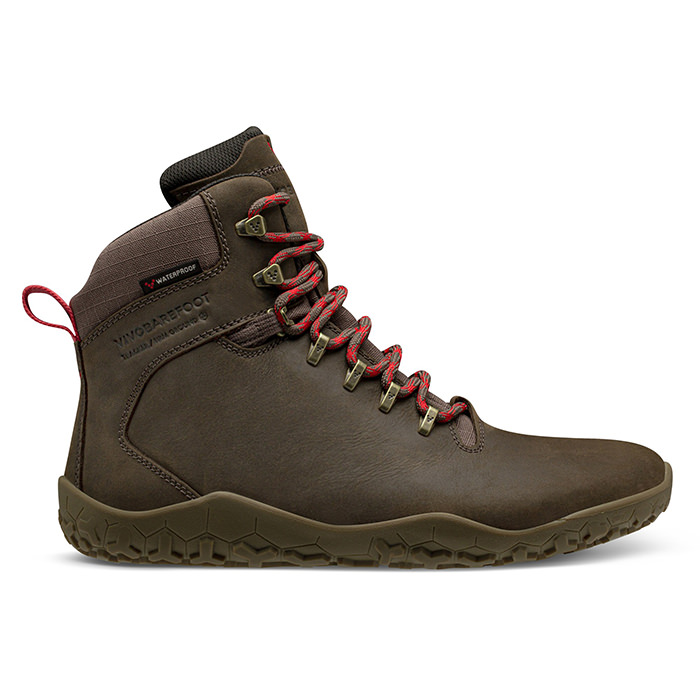
Men’s Vivobarefoot Tracker Forest ESC
Best Zero-Drop Hiking Boots
CleverHiker Rating: 4.1/5.0
Price: $240
Weight (Pair): 2 lb. 9 oz.
Upper Material: leather
Sizing: Regular width
Pros
- Natural foot shape
- Huge toe box
- Barefoot feel
- Great traction
- Shoes can be folded small
- Flexible ankles
- Good weather resistance
Cons
- Heavy for barefoot boots
- Outsole less durable
- Zero-drop shoes aren't for everyone
- Expensive
- Slow to dry
If you want the traction and waterproofing of a boot but don’t need the burly support, the Vivobarefoot Tracker Forest ESC is the pair for you. These are zero-drop, foot-shaped boots for on and off-trail adventures.
They offer an ultra-thin 2.5 mm tread depth, so you’ll feel the contours of roots and rocks on the trail much more than a traditional boot with a stiff sole.
That said, the Forest ESCs offer a very deep tread – 7 mm – that offers good traction on most surfaces. The laces allow for a snug fit, and the rubber paneling and leather uppers offer stylish versatility for strolling in the suburbs or wandering in the wild. These boots give great protection while still allowing your foot to spread and flex naturally.
But, the Forest ESC falls a bit short for weight and durability. They’re a bit heavy for barefoot boots, so if your top priority is keeping your overall weight down, they may fall short. The traction is impressively sticky, but we find the lugs and outsoles wear down faster than other boots.
The soles are so flexible and thin that both shoes can be rolled up into a small package and tucked away, but consistently packing them this way further wears down their materials. And, zero-drop shoes aren’t for everyone – especially if you prefer more padding, arch support, and less ground feel.
That said, the Forest ESCs’ stellar flexibility, a huge toe box, and strong weather resistance is well worth this tradeoff. With a bit of care after regular use, they can last for hundreds of miles. In general, zero-drop boots offer a lower level of support than the beefier boots on our list. But for fast and light adventures that call for more protection than a zero-drop trail runner can provide, these boots are a perfect fit.
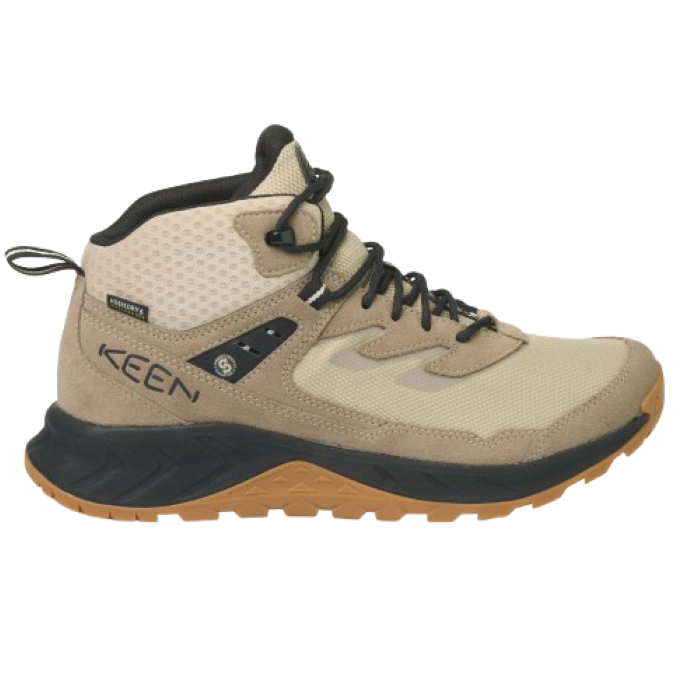
Men’s KEEN Hightrail Mid
Light and Plush Hiking Boot
CleverHiker Rating: 4.4/5.0
Price: $155
Weight (Pair): 1 lb. 14.4 oz.
Upper Material: synthetic mesh, leather
Sizing: wide available
Pros
- comfortable
- lightweight
- flexible
- grippy
- feels more like a sneaker
Cons
- May not fit extra-wide feet
- high heel-to-toe drop
- sizing seems a little off
- not as waterproof as some
The KEEN Hightrail Mid Waterproof is a lightweight hiking boot that wears more like a cushy sneaker than a clunky boot. We wore them straight out of the box with zero break-in headaches as we hit the trails in Colorado and Maryland on our test hikes.
The high-rebound foam plays a starring role, soaking up trail chatter and springing you forward on climbs. It delivers the plush, pillowy ride that some hikers crave. However, if you’re after more of a barefoot-style hiking boot with a lot of ground feel, you’ll want to pass on the Hightrail’s high heel-to-toe drop and cushy construction. Our gear analyst found the boot breathes surprisingly well for a waterproof hiking boot, keeping feet dry without roasting them.
If you’re after a lightweight and waterproof boot that hikes like your favorite sneakers, the Hightrail could be a solid pick.
More: See KEEN Hightrail Full Review
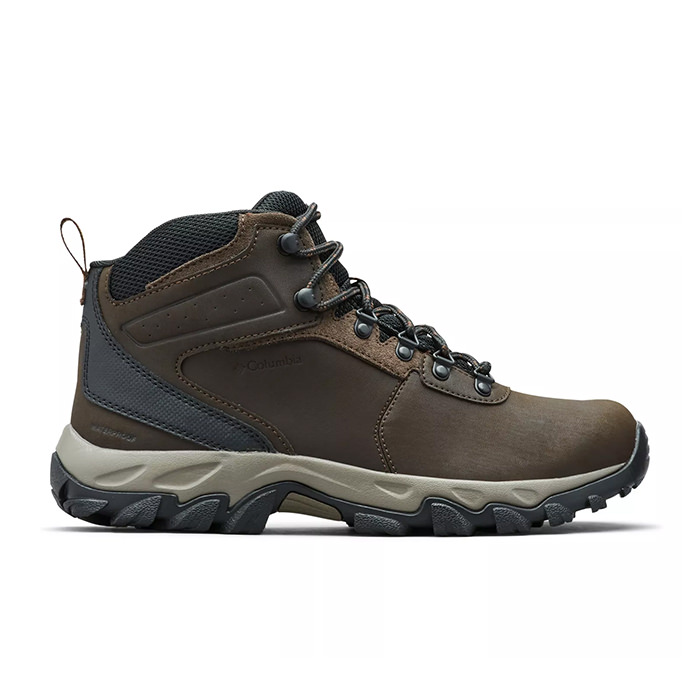
Columbia Newton Ridge Plus 2 WP
Less Expensive Hiking Boots for Occasional Hikes & Beginners
CleverHiker Rating: 4.3/5.0
Price: $100
Weight (Pair): 2 lb.
Upper Material: Poly-coated leather & suede
Sizing: Wide available
Pros
- Affordable
- Lightweight
- Durable
- Supportive
- Many colorways
- Good traction
- Easy to put on and take off
Cons
- Not fully waterproof
- Medium break-in period
- Stiff / minimal cushion
- Looks worn sooner than it is
- Hot above 70°F
If you’re on a tight budget but itching to hit the trail, the Columbia Newton Ridge Plus 2 are the most budget-friendly hiking boots on our list. At only $100, this pair is durable, stable, and offers burly traction. It shines for its classic hiking boot profile featuring a stable, structured outsole and a leather and suede upper. These boots also come in tons of different colors and sizes, ranging from 7 to 17, as well as wide sizing options, so chances are there’s a Newton Ridge design that fits your foot.
On the downside, the Newton Ridge Plus 2s are slower to break in and feel somewhat stiff out of the box and don’t offer quite as much cushioning at the heel or midfoot as others on this list. We also found this pair is not 100% waterproof, so step carefully across those creek crossings.
That said, the Columbia Newton Ridge Plus 2 WP is a less expensive option that doesn’t compromise on style or accessibility. Whether you’re taking the first few steps into the world of hiking, you need a durable boot for a few backcountry trips a year or want a stylish and simple hiking boot to add to your rotation, these are incredibly popular and affordable boots. Although they aren’t ideal for really long hikes, they are a cost-effective way to get into day hiking or short backpacking trips.
Product Comparison Table
| oSort | Product | Price | Weight (Pair) | Upper Material | Sizing | Comfort | Ankle Support | Weight Score | Traction | Weather Resistance | Durability | 0 |
Salomon X Ultra 5 Mid GTX View at REI View at Backcountry |
$185 | 1 lb. 15 oz. | Poly-coated leather | Wide available | 4.7 | 4.8 | 4.8 | 4.7 | 5.0 | 4.9 | 1 |
Lowa Renegade EVO GTX View at REI View at Amazon |
$280 | 2 lb. 10 oz. | Nubuck leather | Wide & narrow available | 4.7 | 5.0 | 4.0 | 4.7 | 4.9 | 4.9 | 2 |
adidas Terrex Skychaser AX5 Mid GORE-TEX CLIMAWARM+ View at REI View at Amazon |
$160 | 2 lb. 1.4 oz. | Ripstop with overlays | regular | 4.7 | 4.7 | 4.6 | 4.6 | 4.8 | 4.7 | 3 |
Salomon Quest 4 GTX View at REI View at Backcountry |
$230 | 2 lb. 14 oz. | Leather/mesh | Regular width | 4.8 | 5.0 | 4.0 | 4.5 | 4.7 | 4.6 | 4 |
Oboz Katabatic LT Mid GTX View at REI View at Amazon |
$190 | 1 lb. 9.6 oz. | Recycled polyester | Wide available | 4.7 | 4.7 | 5.0 | 4.5 | 4.6 | 4.4 | 5 |
La Sportiva Ultra Raptor II Mid GTX View at REI View at Amazon |
$220 | 1 lb. 11 oz. | Poly & plastic | Wide available | 4.6 | 4.5 | 5 | 4.6 | 4.4 | 4.3 | 6 |
Merrell Moab 3 WP View at REI View at Amazon |
$170 | 2 lb. 4 oz. | Leather/mesh | Wide available | 5.0 | 4.6 | 4.5 | 4.8 | 4.7 | 4.7 | 7 |
KEEN Targhee IV WP View at REI View at Amazon |
$180 | 2 lb. 9 oz. | Nubuck leather | Wide available | 4.7 | 4.7 | 4.2 | 4.7 | 4.9 | 4.6 | 8 |
HOKA Anacapa 2 Mid GTX View at REI View at Backcountry |
$195 | 2 lb. 4 oz. | Nubuck leather | Regular width | 4.8 | 4.2 | 4.7 | 4.8 | 4.5 | 4.5 | 9 |
Vivobarefoot Tracker Forest ESC View at Vivobarefoot View at Amazon |
$240 | 2 lb. 9 oz. | leather | Regular width | 4.3 | 4.6 | 4.2 | 4.5 | 4.3 | 4.7 | 10 |
KEEN Hightrail Mid View at REI View at Amazon |
$155 | 1 lb. 14.4 oz. | synthetic mesh, leather | wide available | 4.5 | 4.4 | 5.0 | 4.5 | 4.5 | 4.5 | 11 |
Columbia Newton Ridge Plus 2 WP View at Columbia View at Amazon |
$100 | 2 lb. | Poly-coated leather & suede | Wide available | 4.7 | 4.5 | 4.8 | 4.5 | 4.5 | 4.5 |
|---|
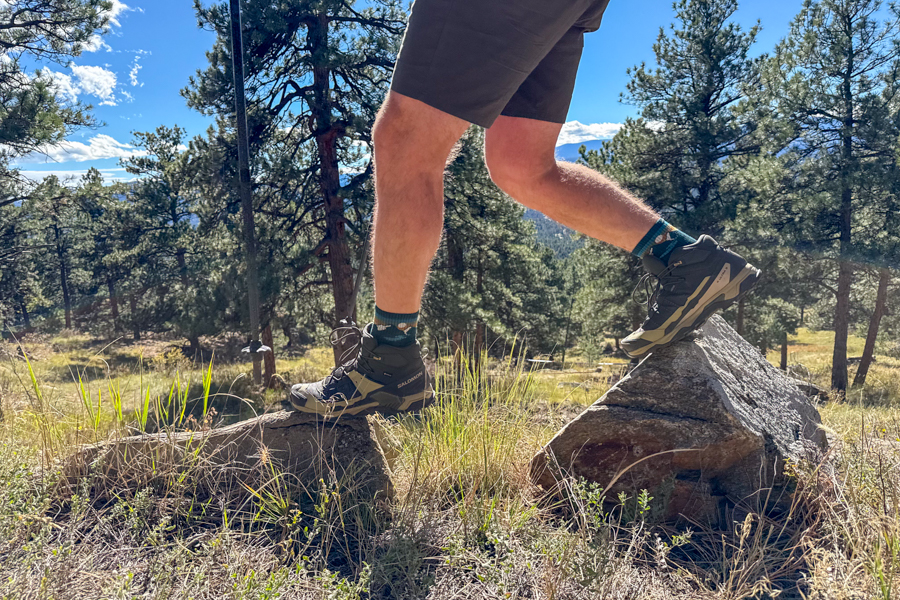
How we Test & Methodology
COMFORT
Comfort is essential when we’re evaluating hiking boots. We hiked on every type of terrain for many miles, noting how each pair performed over the course of many miles. We carefully assess the cushioning and support from the midsole to ensure it can handle longer treks without causing discomfort. We scrutinize the fit and flexibility of each pair, examining how well the boots accommodate different foot shapes and movements – especially during steep ascents and descents. We pay close attention to the insole’s ability to manage moisture and maintain comfort during prolonged use. We also test the boots with different sock thicknesses to determine how well they accommodate various layering options without compromising fit. The break-in period is also critical, which we document based on how quickly and comfortably the boots adapt to our feet. Finally, we consider breathability and temperature regulation, which is key to maintain comfort in different weather conditions and limit overheating and blisters.
ANKLE SUPPORT
Ankle support is one of the most important parts of hiking boots, especially for navigating challenging trails and carrying heavy loads. We test these boots across diverse terrain to evaluate how well each boot stabilizes the ankle. We measure the height and gauge the stiffness of the ankle collar to assess how supportive the boot is without restricting movement. We test lateral stability by navigating side slopes and sharp turns, noting if our ankles feel prone to rolling or twisting in the boots. We also scrutinize the lacing system since it plays a major role in securing the ankle and providing a customized fit. We test different load weights and see how well they maintain support under increased pressure. The overall construction and materials used ensure durability and consistent performance over time.
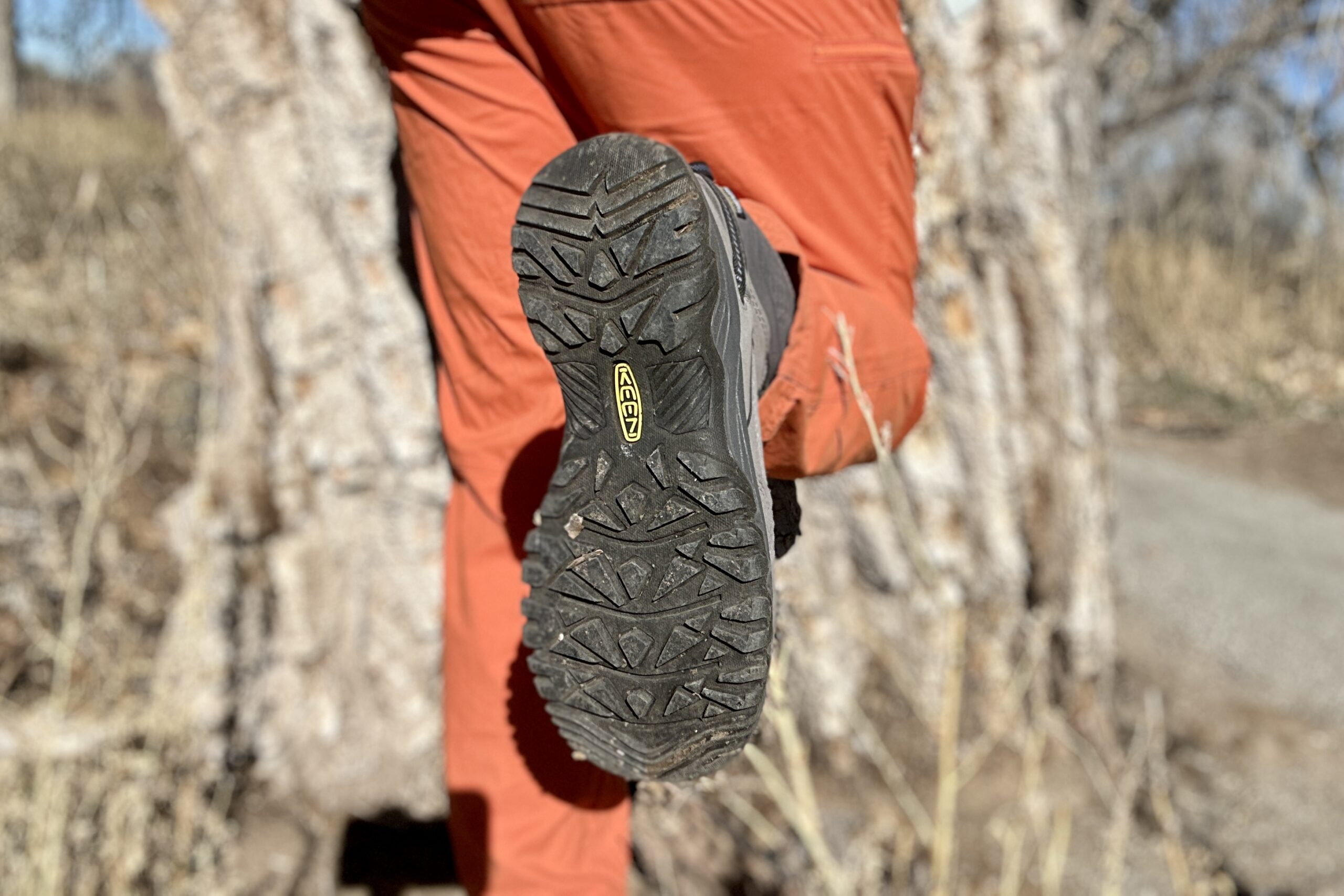
WEIGHT
Weight is a crucial factor when evaluating hiking boots. Weight influences performance on the trail. For accuracy, our testing begins by weighing each boot against the manufacturer’s specs. We then take the boots on a bunch of different types of hikes, from short day trips to multi-day treks looking at how the weight affects muscle and join fatigue and overall agility. Lighter boots usually provide more ease and speed, especially on longer distances, but we also consider the trade-off with durability and support. We pay close attention to how the weight distribution impacts balance and stability on uneven terrain. Testers provide feedback on whether the boots feel heavy or cumbersome after extended wear, which helps us gauge the real impact of the boots’ weight in real-world conditions.
TRACTION
Traction helps your maintain stability and prevents slips on different types of surfaces while you’re hiking. To evaluate each boot’s grip, we seek out a variety of surfaces from loose gravel and wet rocks to muddy trails and steep inclines. We examine the lug pattern and depth, noting how effectively they channel mud and debris while providing solid footing. We carefully check the rubber compounds used in the outsole for wear and tear, as its composition and how it breaks down affects grip over time. We also assess the boots’ performance in wet and dry conditions to see how reliable the traction is in different types of weather.
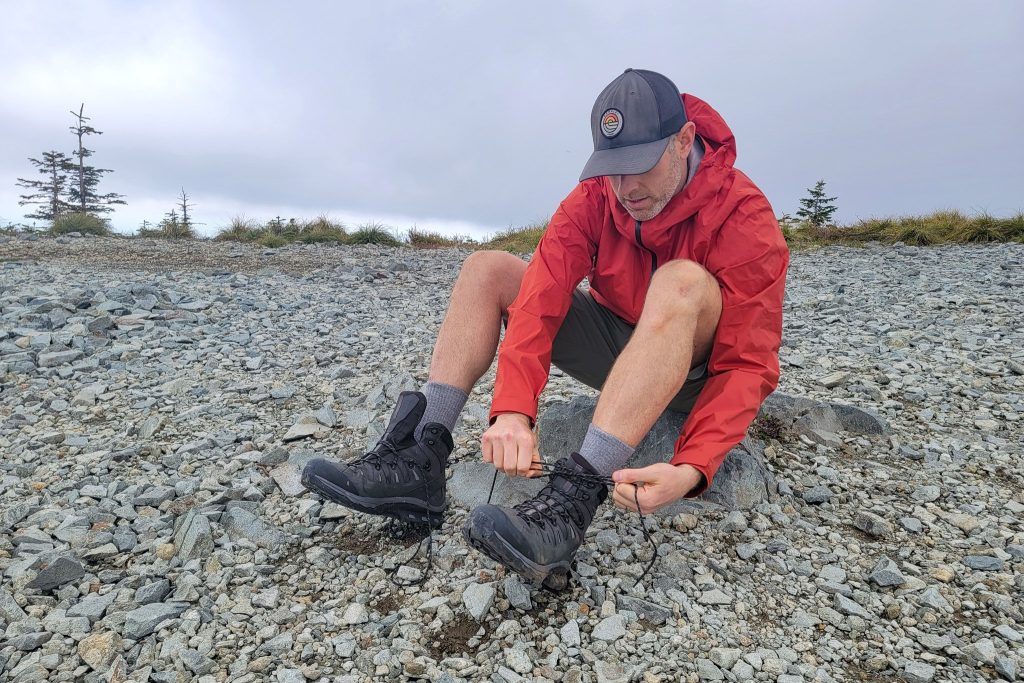
WEATHER RESISTANCE
Dry feet are comfortable feet, no matter what weather conditions you’ll be hiking in. We start by testing each boot’s waterproofing capabilities through immersion: we spend a lot of time walking in these boots in wet environments, from deep snow to streams and puddles. We examine the effectiveness of waterproof membranes like Gore-Tex to prevent water breaching the material, while still allowing breathability. We evaluate the boot’s performance in cold and frigid weather as well, assessing insulation efficiency and the ability to keep feet warm. Testers provide feedback on overall warmth and dryness during prolonged exposure to different weather conditions.
DURABILITY
For durability, we begin by examining the materials and construction, looking carefully at the quality of leather, synthetic fabrics, and stitching. Each pair is subjected to rigorous field tests, including hikes over rocky, muddy, and wet terrains. We also perform controlled abrasion tests to see how the boots withstand scuffing and scraping. We pay special attention to flex points and high-wear areas like the toe and heel, since they need to withstand repeated stress against rocks, branches, dirt, and more. We note any signs of early wear or failure like delamination, seam splits, sole separation, and more. We also track how the boots maintain their structural integrity over time. And, we compare feedback from multiple users to make sure we’re finding consistent durability across different pairs and uses.
Why Trust CleverHiker
Our team of experts has hiked, climbed, and backpacked over 10,000 miles and 2,000 days in hiking boots to find the best of the best. Gear Analyst and lead tester, Ian Krammer, has climbed over 30 Colorado 14ers and over 200 more peaks over 13,000’ in all seasons. His thousands of miles trudging through the Rocky Mountain backcountry over the last 10 years gives him excellent insight into hiking boots. His prior work in quantitative and qualitative research honed his comparative analytics skills, which he used to discern the pros and cons of hiking boots on this list.
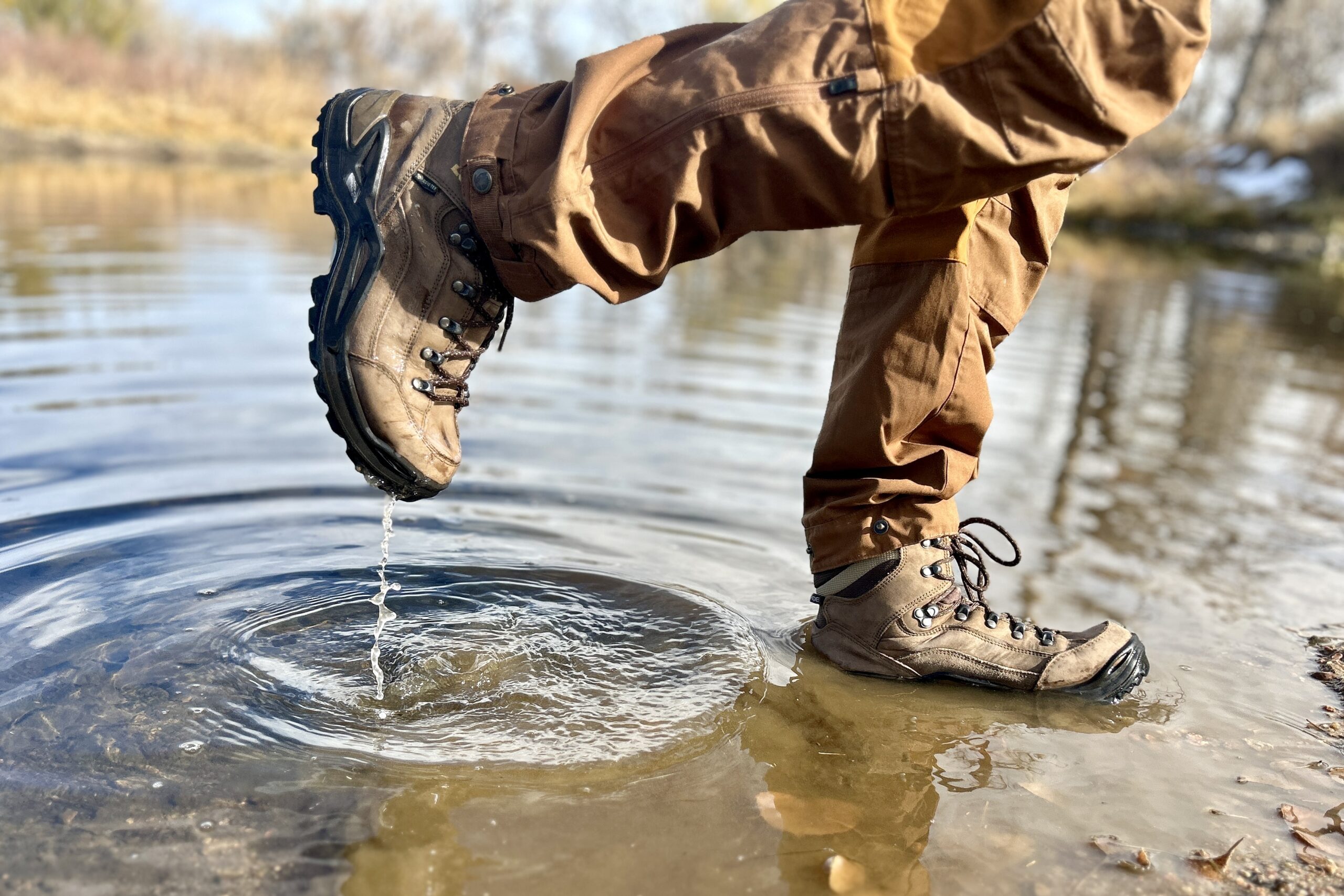
Analysis & Results
See how these hiking boots compare using the six testing criteria above.
VALUE
Price can’t be tested when it comes to hiking boots – but we know how much cost matters. That’s why we keep an eye out for hiking boots that are an outstanding value, which means they’re a great bang for your buck by performing well on the trail without breaking the bank. The Columbia Newton Ridge Plus WP is the most affordable pair of hiking boots on our list with burly leather outsoles, impressive traction, and decent comfort. When it comes to a long-lasting and comfy hiking boot for under $200, the Salomon X Ultra 5 GTX will stand up to rough conditions season after season. The adidas Terrex Skychaser AX5 Mid GORE-TEX CLIMAWARM+ deserves an honorable mention here for being a well-built winter boot for $160.
COMFORT
There are a few boots that stand out as truly cozy footwear on any terrain, straight out of the box, and with minimal break-in. The Merrell Moab 3 WP came out on top for comfort according to our gear analysts.
Tied for second place are the Salomon Quest 4 GTX and the HOKA Anacapa 2 Mid GTX. Both models feature durable leather uppers that mold to the foot over time, complemented by a breathable yet waterproof GORE-TEX membrane and a cushioned midsole that’s easy on your arches. Overall, though, we rated every single boot on this list high for comfort.
ANKLE SUPPORT
When it comes to ankle support, in general, the taller the ankle cuff, the more support the boot offers. Our top pick in this dimension is the Salomon Quest 4 GTX. It is a burly, high boot that conforms closely to the leg and ankle without feeling suffocating or limiting movement. The laces are thick and easy to adjust, and the design feels thick, comfortable, and protective.
The LOWA Renegade boots are a very close second, offering a cushy feel around the ankle with excellent durability and support from a thick leather outer and a soft interior. Like the Quest 4 GTX, it offers highly adjustable laces to dial in the amount of pressure and support around the leg and upper foot.
Rounding out our top three is the other Salomon model on our list, the Salomon X Ultra M5id GTX. While this one has a lower cuff than the other two options on this list, don’t be fooled by its height. This model’s excellent protection at the heel and the front of the leg, combined with the lightweight material that curves below the lateral malleolus (the round bone that sticks out on either side of the foot), makes for a supportive and easy ride on trail.
WEIGHT
The Oboz Katabatic LT Mid GTX tops our list for being a lightweight beast. At 1lb 9.6 ounces per pair, the Katabatic outperforms the previous champion, the La Sportiva Ultra Raptor II Mid GTX.
Moving down the line are the Keen Hightrail Mid Waterproof Hiking Boot and the Solomon X Ultra 5 Mid GTX. Weighing in at only 1lb 13oz and 1lb 15 oz, respectively, these are some of the lightest boots we’ve tested. They both feel a bit more flexible and nimble than most others, even on wet and rocky trails, giving them the feel of burly trail runners more than classic boots. That said, they still offer plenty of protection while you’re moving fast and crushing miles.
The Columbia Newton Ridge Plus 2 WP and the HOKA Anacapa 2 Mid GTX are also lightweight. These both feature lighter materials in their construction, combining leather overlays with advanced synthetic fabrics and innovative, comfortable sole designs. The emphasis on weight reduction enhances hikers’ agility and endurance on the trail, allowing for faster and more comfortable trekking experiences. Their lighter weight will help minimize fatigue, so you can cover longer distances with less strain on your feet and legs.
TRACTION
Our testers preferred the traction of the HOKA Anacapa 2 Mid GTX and Merrell Moab 3 Mid WP. One of our testers also gave a shout out to the LOWA RenegadeEVO in this category. The Renegade boasts exceptional traction thanks to careful engineering and a great lug design.
WEATHER RESISTANCE
The most weather-resistant hiking boots in our testing are the Salomon X Ultra 5 Mid GTX, which features a GORE-TEX membrane that delivers excellent waterproofing while maintaining solid breathability. Its synthetic upper dries quickly after creek crossings or rainstorms, and the reinforced toe cap and full mudguard add crucial protection in slushy snow or wet trail conditions. It’s a dependable option for hikers expecting variable weather, especially in mountain or shoulder-season environments.
The LOWA Renegade EVO GTX and KEEN Targhee IV also earn high marks for weather protection. The Renegade combines a GORE-TEX liner and robust Nubuck leather upper. The full-height design helps seal out water and debris, while the secure lacing and padded collar provide a snug, weather-blocking fit. The KEEN Targhee IV WP uses KEEN’s in-house KEEN.DRY membrane, which remains effective in wet weather. Its leather and mesh upper dries reasonably quickly, and the DWR coating offers additional protection during light rain or stream crossings.
The adidas Terrex Skychaser AX5 Mid GTX is another standout when it comes to waterproofing. It’s built with a GORE-TEX bootie-style liner and a dense mesh upper that repels water surprisingly well for a synthetic boot. It’s also the only insulated boot on this list, which means it will keep your feet warmer in snow and wintry weather.
DURABILITY
The Lowa Renegade GTX takes our top slot for the most durable boots on our list. With an all-leather construction, they offer stellar durability, outstanding foot protection, and excellent traction. The classic leather hiking boot design not only provides great durability but also reliable performance across all terrain and conditions, from well-packed trailers to challenging scrambles and off-trail adventures.
The Salomon X Ultra 5 GTX is right behind, thanks to its burly and long-lasting design. These boots offer excellent durability for traversing rough terrain with ease, including a thick toe cap, poly-coated leather uppers and robust design for longevity. The geometric lug pattern provides superior traction that stands up to rocks and dirt, and feels secure and stable on trail.
Also at the top of the list, the Salomon Quest 4 GTX has seriously burly durability. A mix of leather and mesh textiles gives the boots a long life on the trail with minimal maintenance.
How to Choose Hiking Boots
SIZING
Ensuring the right fit for your hiking boots is crucial for staying comfy on trail. We recommend boots at least a half size larger than your regular size, especially if you’re at the edge of one size or between sizes. Though the larger fit might feel a bit awkward at first, it accounts for foot swelling during long hikes and big-mile days. With more room, your toes can wiggle freely and your foot can move naturally, making your hike more comfortable.
The finger test is a practical way to evaluate how well your boots fit. Loosen the laces then place your foot inside the boot with toes against the front of the toe box. Then, gently slide your index finger between your heel and the back of the shoe. If your finger fits easily, you’ll minimize the risk of toe jamming during steep descents, reducing the likelihood of hot spots, pain, and nail damage. This bit of extra space is also to accommodate the thickness of socks you plan to wear.
Different sock types can impact overall comfort, so when you’re trying on shoes, be sure to wear the hiking socks you plan on wearing on your hike. If you plan to use aftermarket insoles, the extra room fits the curves and shape of the insole that’s best for your foot.
BREAK-IN PERIOD
Are you planning to strap on those boots and hit the trail immediately? You might want to rethink that plan. Although many of the boots on this list offer instant comfort, almost all of them require a break-in period. That’s why we recommend wearing the boots, shoes, or trail runners you plan to backpack or hike with for at least 1-2 weeks before you start hiking in them.
Consider wearing your new boots during regular activities to help them mold to your foot. Whether you’re running errands, commuting to your favorite coffee shop, or walking the dog on city trails, give your fresh kicks as much time to soften around your unique foot as possible. Plus, familiarizing yourself with them will give you plenty of time to iron out any concerns before you’re miles deep in the woods.
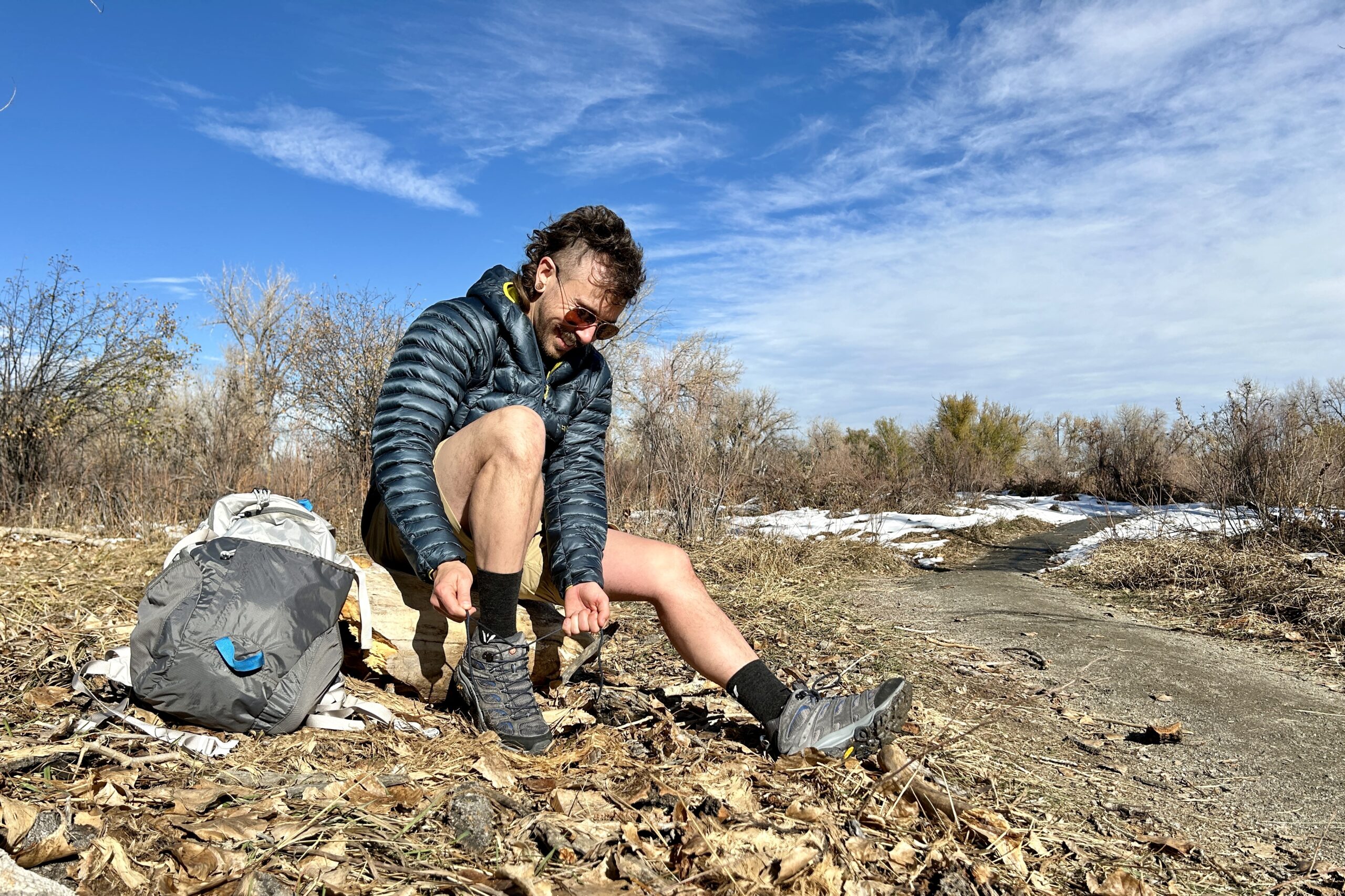
TRACTION
Hiking requires boots with a strong outsole and outstanding grip pattern. Whether you’re slipping and sliding through marshy, slick creekside trails or picking your way across uneven and jagged scree fields, the amount of traction your boots offer is vital to your comfort and stability. Your boots should grip well in most if not all landscapes and conditions. Rest assured that lug pattern, traction, and grip were front and center in our decision-making process when curating this list.
MANAGING MOISTURE & BLISTERS
If you hike regularly, wet feet are inevitable – no matter what shoes or boots you’re wearing, or if they’re waterproof. From massive rainstorms to deep puddles, wet feet can be the cause of major issues on a hike. Wet conditions inside your feet can quickly lead to hot spots, blisters, and pain. Luckily, a healthy foot care routine can thwart much of the damage. For our favorite tips on how to manage moisture and handle blisters, see our guide How to Prevent and Treat Blisters.
WATERPROOFING TREATMENTS
Waterproof hiking shoes are our go-to on soggy days when the trail is full of mud, lined with snow, or the forecast looks rainy. However, water will still, eventually, find its way into your shoes. Heavy rain, light mist, and wet vegetation lining the trail can easily drip down your legs and into your shoes. Since waterproof treatments wear off over time, you’ll need to reapply a waterproof treatment to keep your shoes sealed.
INSOLES
Whether you’ve got pristine, healthy, young feet or you’re dealing with long-term injuries or chronic conditions like plantar fasciitis, flat feet, or shin splints, we do recommend upgrading to aftermarket insoles. Aftermarket insoles not only help beat foot fatigue, but they can provide essential extra stability, more cushion, and increased arch support. Aftermarket insoles are really beneficial for those seeking a remedy to rigid or minimally supportive boots. They can also take up a bit more space to get a more customized fit for folks who are stuck between sizes or simply want a tighter feel.
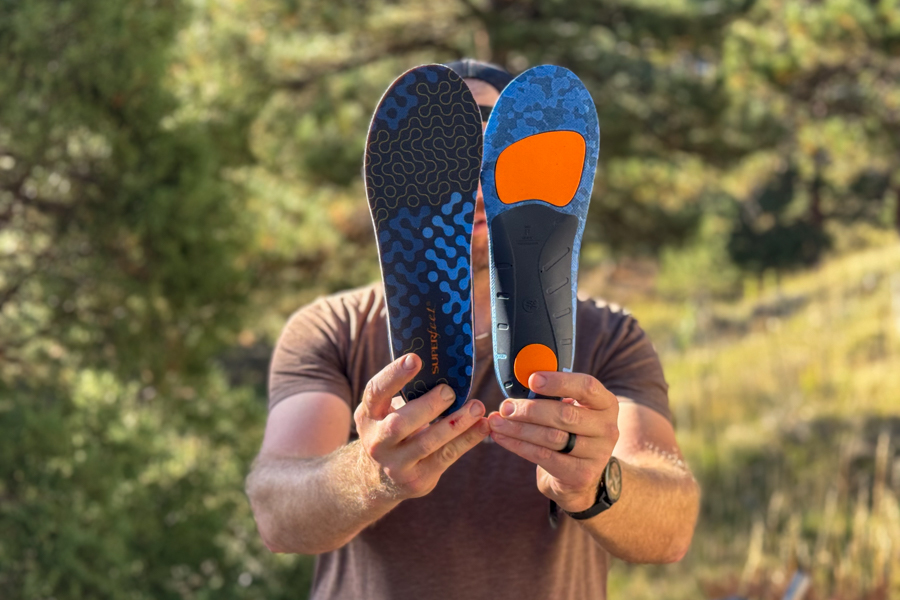
SOCKS
Take it from us – quality socks are just as important as quality shoes. Our team has hiked thousands of miles over the years, and we’ve learned that well-made, appropriately fitted socks are essential for not only the health of your feet but your peace of mind on trail. Check out our guide to the Best Hiking Socks for some of our top suggestions and all-time favorites for comfort, durability, moisture-wicking, and fast-drying features.
Conclusion
Choosing the perfect hiking boots can be a daunting task, especially with so many options available. We hope this guide helps you navigate the features and benefits of each model so you can find the perfect pair for your next adventure. Whether you’re tackling rugged terrain or exploring mellow local trails, the right boots will make every step comfortable and secure.




